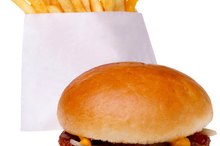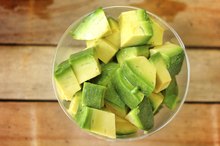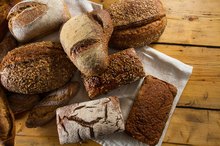What Are the Functional Groups in Cholesterol?
Cholesterol fills such important roles that your body makes its own supply rather than depending on dietary sources. Two of its jobs -- making bile acids and creating the outer coating of cells -- rely on chemical structures in the cholesterol molecule called functional groups. While cholesterol is not soluble in water, within the molecule, one type of functional group is water-soluble and another is insoluble. It turns out this dual characteristic plays an essential role.
Types of Functional Groups
Molecules are made from atoms, which sometimes combine to form a specific group of atoms. These are called functional groups because they’re responsible for precise tasks in your body. Functional groups also define unique characteristics of a molecule. Cholesterol has two types of functional groups. The first one, called a hydrocarbon functional group, consists of atoms of hydrogen and carbon. In cholesterol, the hydrocarbons connect to form two different shapes -- rings and chains. The second group, called a hydroxyl group, contains one atom each of hydrogen and oxygen.
- Molecules are made from atoms, which sometimes combine to form a specific group of atoms.
- The second group, called a hydroxyl group, contains one atom each of hydrogen and oxygen.
Group Characteristics
Bile and Fat Digestion
Learn More
Four hydrocarbon rings form the middle of the molecule. This functional group is the same one found in steroid hormones synthesized from cholesterol. A chain of hydrocarbons extends from one side of the nucleus, creating a hydrocarbon tail. One hydroxyl group is connected to the opposite side of the nucleus. There is one important difference between the groups: Hydroxyl groups are soluble in water, while hydrocarbons are not water-soluble. A molecule that has soluble and insoluble regions is called amphipathic. This amphipathic quality is vital for cholesterol to fill a few essential jobs.
- Four hydrocarbon rings form the middle of the molecule.
- This functional group is the same one found in steroid hormones synthesized from cholesterol.
Cholesterol in Cell Membranes
Every cell throughout your body is surrounded by a membrane, which consists of proteins, phospholipids and cholesterol. Phospholipids form most of the membrane’s structure. They’re amphipathic and shaped like a matchstick, with insoluble fatty acids forming the stick and a soluble phosphate functional group at the top. Cholesterol’s hydroxyl group can attach to the phosphate head, while its hydrocarbons connect to the phospholipid’s fatty acids. Cholesterol adds rigidity to the phospholipids, which are fluid and constantly moving. It also regulates what can get through the membrane by making it less permeable and anchors proteins to the membrane.
- Every cell throughout your body is surrounded by a membrane, which consists of proteins, phospholipids and cholesterol.
- Cholesterol adds rigidity to the phospholipids, which are fluid and constantly moving.
Digestive Support
What Role Do Lipids Play in the Human Body?
Learn More
After carbohydrates and proteins are digested, they go straight into your bloodstream because they’re water-soluble. Because:
- dietary fats
- including vitamins A
- E
- D
- K
- are insoluble
- they follow a different digestive process that depends on the presence of bile acids
Your body uses cholesterol to produce bile. Once again, cholesterol’s amphipathic nature is essential, reports Colorado State University 2. First, it creates a detergentlike action that breaks fats down into tiny droplets. Then bile’s fat-soluble functional group clumps around the small droplet, leaving the water-soluble group on the outside surrounding the fat. This structure, called a micelle, allows the fat droplet to enter the lining of the small intestine, where it can be absorbed into your bloodstream.
- After carbohydrates and proteins are digested, they go straight into your bloodstream because they’re water-soluble.
- Then bile’s fat-soluble functional group clumps around the small droplet, leaving the water-soluble group on the outside surrounding the fat.
Related Articles
References
- Royal Society of Chemistry: In and Out of Cells: Cells, Membranes and Walls
- Colorado State University: Secretion of Bile and the Role of Bile Acids in Digestion
- Elmhurst College: Micelles
- Royal Society of Chemistry: Some Basic Chemistry: Living Organisms and Chemistry
- Estrella Mountain Community College: Cell Membrane
Writer Bio
Sandi Busch received a Bachelor of Arts in psychology, then pursued training in nursing and nutrition. She taught families to plan and prepare special diets, worked as a therapeutic support specialist, and now writes about her favorite topics – nutrition, food, families and parenting – for hospitals and trade magazines.









